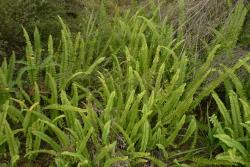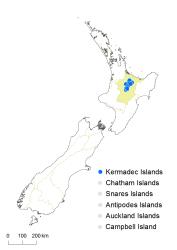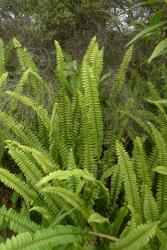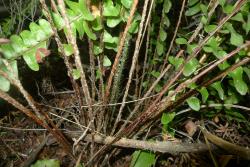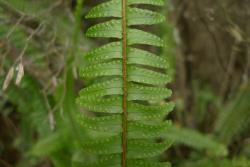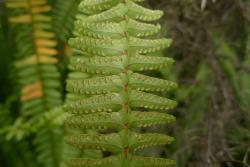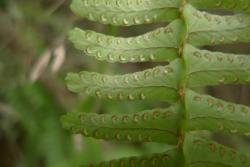- Taxon
- Gallery
Terrestrial ferns. Rhizomes erect, abundantly scaly, producing long-creeping runners with adventitious buds, lacking tubers. Rhizome scales spreading, narrowly ovate or linear, tapering from a narrow or occasionally broadened base to a filiform apex, 3–5 mm long, 0.2–0.5 mm wide, peltate, light brown, dull, margins entire. Fronds 200–750 mm long. Stipes 25–160 mm long, pale brown, brittle, bearing scattered scales. Rachises pale brown; rachis scales scattered, spreading, narrowly ovate to linear, light brown, margins lacerate at base. Laminae 1-pinnate, narrowly elliptic to linear, tapering to apex; fertile laminae 170–620 mm long, 18–50 mm wide, or rarely to 55 mm wide, yellow-green on both surfaces, herbaceous; scales absent or with very scattered hair-like scales, multicellular hairs sometimes present. Primary pinnae in 35–85 pairs, not or slightly overlapping; the longest near the middle, 9–25 mm long, or rarely to 30 mm long, 4–8 mm wide, narrowly ovate or oblong with a small obtuse basal acroscopic lobe, slightly falcate; basal pinnae much reduced; pinna apices obtuse or rounded, margins serrate or lobed, bases short-stalked and unequally auricled. Sori round, closer to margin than costa; indusia lunulate or occasionally reniform with broad sinus, attached at base, 0.5–1 mm long. Mean spore size 36–38.5 μm long, 23–25 μm wide; perispores pale brown, tuberculate.
Nephrolepis flexuosa is an indigenous species, which is very similar to the naturalised N. cordifolia. It is distinguished by the absence of tubers on its long-creeping runners, by its less obviously scaly rhizomes and stipe bases, and by its generally shorter and narrower laminae (170–620 mm long, 18–50 mm wide, cf. 240–1020 mm long, 30–100 mm wide). The rhizome scales are also shorter and much narrower (3–5 mm long, 0.2–0.5 mm wide, cf. 5.5–7 mm long, 0.9–1.7 mm wide), with entire rather than lacerate bases. Nephrolepis flexuosa is a tetraploid species (2n = 164) and has larger spores than the diploid N. cordifolia (36–38.5 μm long, 23–25 μm wide, cf. 28–33 μm long, 18–22 μm wide). It is distinguished from both N. brownii and N. exaltata by its usually lunulate, rather than reniform, indusia.
North Island: Volcanic Plateau.
Kermadec Islands
Altitudinal range: 20–760 m.
In the Kermadec Islands, Nephrolepis flexuosa occurs only on Raoul Island. It is also found in thermal areas of the North Island, from Rotorua to Lake Taupō. On Raoul Island it has been recorded in permanent plots from near sea level to 400 m (C.J. West, pers. comm.), but it also occurs up to 516 m on Moumoukai Summit. In thermal areas of the North Island it reaches 760 m near Wairakei.
Also reported from Lord Howe Island, Norfolk Island, Fiji (de Lange et al. 2005) and the Cook Islands (Sykes 2016) (see below).
On Raoul Island, Nephrolepis flexuosa is abundant throughout the main forest associations of the island, as well as in shrubland and around fumaroles, on banks, at the base of old slips, along roads and tracksides, on boulders and cliff faces, and commonly as an epiphyte (Sykes 1977; P.J. de Lange pers. comm.). In the North Island it is found on thermally heated ground, beside hot streams and springs, and on steaming cliffs. It is also occasionally found as an epiphyte on Pinus radiata.
Nephrolepis flexuosa was given a conservation status of At Risk / Naturally Uncommon by de Lange et al. (2018).
n = 82, 2n = 164 (de Lange et al. 2004; de Lange et al. 2005).
This species was first recorded in New Zealand by Hooker (1864) as Nephrolepis tuberosa (Bory) C.Presl based on specimens collected by Hochstetter and Sinclair from "hot springs near Waikati". Colenso (1888) later described his N. flexuosa from hot streams at Tapuaeharuru and hot springs at Wairakei, convinced that it was different to N. tuberosa as described and illustrated from overseas localities by earlier authors. However, Cheeseman (1906) referred all New Zealand material, including Colenso’s species, to N. cordifolia (L.) C.Presl. He cited collections from thermal sites in the North Island, adding Raoul Island only in the second edition of his Manual (Cheeseman 1925). Allan (1961) used the same name but provided no further information. Crookes (1963) stated that N. cordifolia was "found only in the thermal district". However, she also noted that "it is easily cultivated and indeed flourishes as a garden escape … it is likely that these vigorous ferns derive, in many cases, from imported, cultivated specimens, but I do not have precise information on the subject". This was the first suggestion that there might be two forms of the species in New Zealand, which was followed by Chinnock (in Heath & Chinnock 1974), who recorded the presence of an adventive species "common around Auckland and other centres" that was larger than the thermal species and bore small, potato-like tubers. The two forms were referred to different species by Brownsey et al. (1985) and illustrated by Brownsey & Smith-Dodsworth (1989), but the thermal species remained without a formal name until de Lange et al. (2005) reinstated Colenso’s N. flexuosa as an indigenous species distinct from the introduced N. cordifolia. Hovenkamp & Miyamoto (2005) published their review of Nephrolepis world-wide at about the same time. They recognised three varieties of N. cordifolia and specifically stated that the native species of Brownsey & Smith-Dodsworth (1989) was the same as their N. cordifolia var. cordifolia. However, in our opinion, the morphological and cytological characters detailed above are sufficient to recognise N. flexuosa as a species distinct from N. cordifolia.
How far N. flexuosa extends beyond New Zealand is unclear. It has been reported from Lord Howe Island, Norfolk Island and Fiji by de Lange et al. (2005), and from the Cook Islands by Sykes (2016). Hovenkamp & Miyamoto (2005) described a very similar entity as N. cordifolia var. pseudolauterbachii from Vanuatu, Fiji and Samoa, differing from the type in having smaller fronds and sinuose fertile pinnae, both characters that are associated with N. flexuosa. However, sequence data from Fijian material (L.R. Perrie unpub.) suggest that at least some plants are more similar to N. lauterbachii, otherwise only known from Papua New Guinea, the Moluccas and Solomon Islands (Hovenkamp & Miyamoto 2005). The identity of the species occurring in Fiji and other south-west Pacific islands therefore requires further investigation.
The possibility that the variety described from Queensland by Domin (1913) as N. radicans var. cavernicola belongs to N. flexuosa also needs further investigation. Andrews (1990) and Bell (1998) both characterised it as a non-tuberous form related to N. cordifolia.



